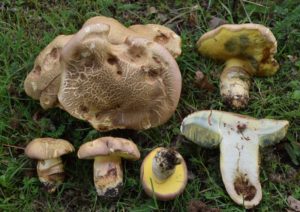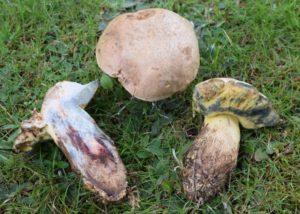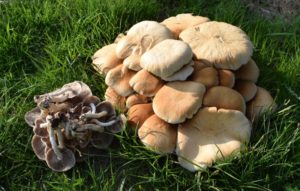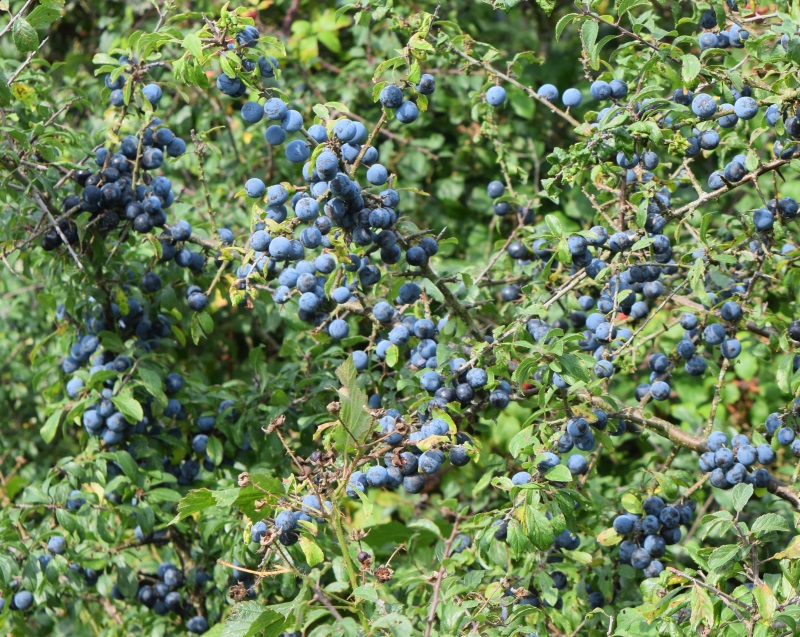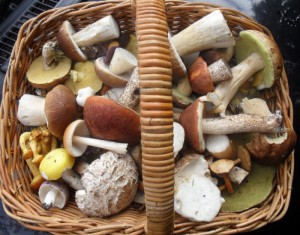Email: geoff@geoffdann.co.uk
28/08/2018
I love this time of year. The oppressive hot weather has gone, and nature is at its most abundant for a forager. Best of all, it has been 9 months since mushroom season ended and I don’t have many foraging clients, so I actually get to remember what my hobby was like before it became my job. And because every year is different, it’s never boring.
The opening of mushroom season 2018 is quite selective – a lot of things aren’t fruiting at all – but the things that are fruiting are doing so very abundantly. Most predominant of all are the large boletes. This morning I found the biggest flush of Oak Boletes (Butyriboletus appendiculatus) I have seen in many years, and finally got a photo that eluded me while collecting photos for my book (the photo of this species in the book is one of the few that aren’t my own). This is an absolutely first class edible – my wife Cathy ranked it higher than a Penny Bun (Boletus edulis), and I’m tempted to agree with her. Our six month old daughter Dorothy was also impressed. They are sweet, and almost crunchy even when cooked. Do be careful
though – there were some very similar-looking mushrooms under the next tree, no more than ten metres away, but these were the poisonous and bitter Rooting Bolete (Caloboletus radicans). Apart from the taste, the most obvious differences are slight differences in the colour scheme, and the patterning on the stem (compare photos).
I actually spotted these Oak Boletes yesterday and went back to photograph them this morning, and their abundance prompted me to spend the afternoon seeing what else I could find. The result was a very wide selection of large boletes, including Summer Boletes (B. reticulatus), Penny Buns, Lurid Boletes (Suillelus luridus),
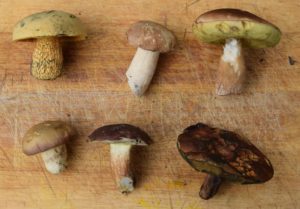
Clockwise from top left: Lurid Bolete, Summer Bolete, Penny Bun, Oak Bolete, Bay Bolete, Scarletina Bolete
Scarletina Boletes (Neoboletus luridiformis) a couple of Bay Boletes (Imleria badia), as well as handful of smaller species. Dark Penny Buns (B. aereus) are also fruiting in south-east England, but I didn’t see any today. These species typically do well after a long, hot summer, so this is not unexpected.
Another edible species that is really going for it is The Blusher (Amanita rubescens), which is having its best year in a long time. There’s a decent amount of various members of the Agaricaceae about (Agaricus species, Parasols and Shaggy Parasols, Giant Puffballs), and I found a big fruiting of one of my absolute favourites – Poplar Fieldcap (Cyclocybe cylindracea).
Some things are missing though, including some boletes: I haven’t seen a single Leccinum, nor a Suillus. There are a few brittlegills (Russula) about, but nothing like what you’d expect in a good year for this group. I haven’t seen any chanterelles or any of their relatives either, and I’m expecting a quiet year for these after they fruited so prolifically last year. No sign of the rest of the Amanitas either, apart from a couple of False Blushers (Amanita spissa) – no Deathcaps (A. phalloides).
All things considered, it’s looking pretty good for this year’s mushroom season. I expect the things that are missing will start turning up in the next two or three weeks.
Finally, it is also looking like an exceptional year for sloes.
Good luck and stay safe!
Geoff

